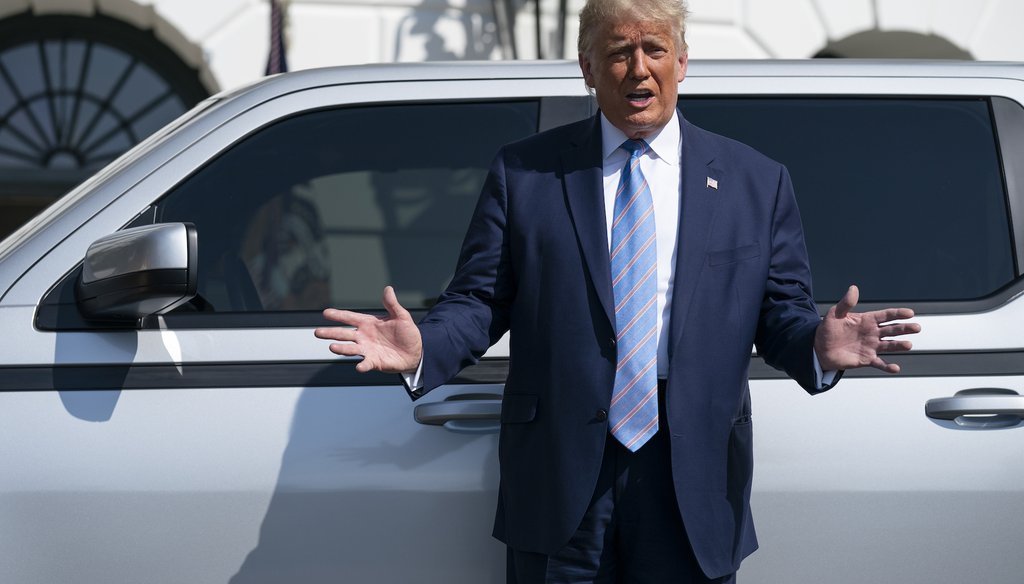Get PolitiFact in your inbox.

President Donald Trump talks about the Endurance all-electric pickup truck, made in Lordstown, Ohio, at the White House on Sept. 28, 2020. (AP)
In President Donald Trump’s 1987 book about business, "The Art of the Deal," he sums up his approach to promotion in a word: "Bravado."
"I play to people’s fantasies," he writes. "People may not always think big themselves, but they can still get very excited by those who do. That’s why a little hyperbole never hurts. People want to believe that something is the biggest and the greatest and the most spectacular. I call it truthful hyperbole. It’s an innocent form of exaggeration — and it’s a very effective form of promotion."
Innocent or not, Trump has returned to this well many times over the course of his presidency. Here’s some hyperbole from the past year that wasn’t truthful.
"I was the person who saved pre-existing conditions in your healthcare."
We rated that Pants on Fire. In January, Trump took credit for a consumer protection in the Affordable Care Act, the health care law that was enacted during Barack Obama’s presidency. The law bans health insurers from discriminating against people with preexisting conditions. Trump has supported repealing the law, effectively taking those consumer protections away.
Jonathan Oberlander, a health policy professor at the University of North Carolina-Chapel Hill, called the claim "part fantasy, part delusion, part politics, and all lie."
The USMCA is the "biggest trade deal ever made."
When Trump declared the USMCA — an agreement between the United States, Mexico and Canada to replace NAFTA — the biggest trade deal ever, we rated that False. It is the largest trade multilateral agreement signed by the United States. But there have been bigger trade deals around the world. In 2018, for example, the European Union signed a trade agreement with Japan that covered a quarter of the global economy and 600 million people.
The USMCA, meanwhile, mostly updated NAFTA, which had been in place since 1994 and was previously the largest U.S. trade deal ever signed. The new agreement also added significant changes for the auto industry and implemented new policies on intellectual property protection, the Canadian dairy market, and labor and environmental standards.
"Anybody that wants a test can get a test."
A few days after federal officials approved widespread testing for COVID-19 in the United States, Trump said that anyone could get tested if they so wanted. At the time, that was False — the Centers for Disease Control and Prevention authorized only health care providers to decide whether someone could get tested, not individuals.
"We’ve done more tests in eight days than South Korea has done in eight weeks."
We rated that False. As the coronavirus cases grew in the United States, Trump boasted about his administration’s response to the disease, arguing that it would soon be under control because American efforts to test for COVID-19 were superior to those in other countries. But when he claimed that more tests had been conducted in the United States in about a week compared with the number of tests in South Korea over eight weeks, the best numbers available at the time didn’t back that up.
As of March 24, when Trump made the claim in a Fox News town hall, about 348,582 people in South Korea had been tested since it started testing people in early February. A credible database of U.S. testing estimated that between March 15 and March 24, only 331,000 people had been tested in the United States.
That’s close to how many people had been tested in South Korea, but it doesn’t account for the countries’ different population sizes. South Korea is home to about 51.5 million people. The United States has about 327 million. If you consider tests per capita — the more important measure — South Korea’s efforts were six times higher than those in the United States.
"We’ve tested more than every country combined."
About a month later, Trump upped the ante. But he was wrong again. At the time, the United States had performed more COVID-19 tests than any other single country, but not more than all major countries combined.
Plus, experts say the raw number of tests isn’t a good metric. Controlling for population and considering other meaningful statistics, the United States was lagging far behind other countries. Later, Trump claimed the United States’ COVID-19 "numbers are better than almost all countries," but that was wrong, too.
Ninety-nine percent of COVID-19 cases "are totally harmless."
False. Trump underplayed the risk of COVID-19, but his own government’s data didn’t back it up. According to the CDC, looking at the worst possible outcome, the cumulative death rate for COVID-19 is 4.5%. And the rate at which new cases lead to hospitalizations was about 4% when he made this claim in early July. It also discounts people who may have mild cases of the disease and still suffer from medical problems after they’ve recovered.
"We have one of the lowest mortality rates in the world."
No fewer than 15 advanced, industrialized nations had a lower mortality rate than the United States when Trump said this during a Fox News interview on July 19. Other countries, including Brazil, Mexico, South Africa, Russia, Turkey, Argentina and India were also faring better. His later claim that "only 6% of the people actually died from COVID" and that others "died from other reasons" earned a Pants on Fire rating.
Children are "almost immune from this disease."
That’s wrong. As Trump advocated for schools to reopen across the country, he made the case that kids were unlikely to catch COVID-19. But research shows that children can catch the disease. They make up about 7.3% of cases in the United States. And as schools have reopened around the world, cases have spread there.
"We’re setting record job numbers."
Trump said this after he was asked during a press briefing on July 21 whether Americans should judge the president on how he’s handled the pandemic when they vote in November. We rated it Mostly False. He was referring to month-over-month employment increases in May and June 2020 — they were the highest increases of any month since the federal government started tracking the statistic in 1939.
But other economic metrics didn’t paint such a rosy picture at that time. The unemployment rate under Trump was up, while the total number of working Americans was down. And the gains that Trump boasted about followed historically large job losses — they only accounted for only 37% of the 20.5 million jobs lost in April.
"I saved the U.S. auto industry … We brought you a lot of car plants" and Japan "announced five car companies are coming to Michigan."
At a campaign rally in the Great Lakes State, Trump claimed the Obama administration nearly killed the auto industry and then spun this False tale about how his administration has done one better. In reality, Trump didn’t save the auto industry. Major automakers in the United States recovered during the Obama administration and after 10 strong years, employment fell in the industry during Trump’s administration, even before the pandemic.
Trump also didn’t bring many new plants. And while Japanese car companies have expanded in the United States, none have been announced for Michigan.
Our Sources
Fast Company, "I call it truthful hyperbole": The most popular quotes from Trump’s "The Art of the Deal," April 4, 2017
PolitiFact, Trump’s claim that he ‘saved’ pre-existing conditions ‘part fantasy, part delusion,’ Jan. 14, 2020
PolitiFact, Trump says the USMCA is the biggest trade deal ever — but there’s been bigger, Feb. 6, 2020
The New York Times, A timeline of the coronavirus pandemic, Aug. 6, 2020
PolitiFact, Donald Trump’s wrong claim that ‘anybody can get tested for coronavirus, March 11, 2020
PolitiFact, Donald Trump’s comparison of US South Korea coronavirus testing is wrong. Here’s why, March 25, 2020
PolitiFact, Donald Trump exaggerates number of untapped coronavirus testing labs, April 23, 2020
PolitiFact, Donald Trump’s claim that US tested more than all countries combined is Pants on Fire wrong, April 30, 2020
PolitiFact, Donald Trump’s false claim that 99% of COVID-19 cases are harmless, July 6, 2020
PolitiFact, Donald Trump wrong to say U.S. has "one of the lowest mortality rates in the world" from COVID-19, July 20, 2020
PolitiFact, Unpacking Donald Trump’s statement on ‘record job numbers,’ July 24, 2020
PolitiFact, Trump’s false claim that children are ‘almost immune’ to COVID-19, Aug. 6, 2020
PolitiFact, Aug. 18, Donald Trump says US is at the top globally in COVID-19 fight. It isn’t, Aug. 18, 2020
PolitiFact, Trump repeats false claim about COVID-19 deaths on Fox News, Sept. 3, 2020






















